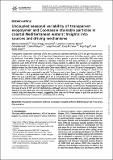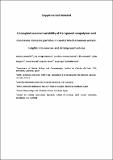Por favor, use este identificador para citar o enlazar a este item:
http://hdl.handle.net/10261/258537COMPARTIR / EXPORTAR:
 SHARE SHARE
 CORE
BASE CORE
BASE
|
|
| Visualizar otros formatos: MARC | Dublin Core | RDF | ORE | MODS | METS | DIDL | DATACITE | |

| Título: | Uncoupled seasonal variability of transparent exopolymer and Coomassie stainable particles in coastal Mediterranean waters: Insights into sources and driving mechanisms |
Autor: | Zamanillo Campos, Marina CSIC ORCID; Ortega-Retuerta, E. CSIC ORCID; Cisternas-Novoa, Carolina; Marrasé, Cèlia CSIC ORCID ; Pelejero, Carles CSIC ORCID ; Pascual, Josep; Gasol, Josep M. CSIC ORCID ; Engel, Anja; Simó, Rafel CSIC ORCID | Palabras clave: | Transparent exopolymer particles Coomassie stainable particles Mediterranean Sea Time series Phytoplankton |
Fecha de publicación: | dic-2021 | Editor: | BioOne | Citación: | Elementa: Science of the Anthropocene 9(1): 00165 (2021) | Resumen: | Transparent exopolymer particles (TEP) and Coomassie stainable particles (CSP) are gel-like particles, ubiquitous in the ocean, that affect important biogeochemical processes including organic carbon cycling by planktonic food webs. Despite much research on both groups of particles (especially TEP) over many years, whether they exist as distinctly stainable fractions of the same particles or as independent particles, each with different driving factors, remains unclear. To address this question, we examined the temporal dynamics of TEP and CSP over 2 complete seasonal cycles at 2 coastal sites in the Northwestern Mediterranean Sea, the Blanes Bay Microbial Observatory (BBMO) and the L’Estartit Oceanographic Station (EOS), as well as their spatial distribution along a coast-to-offshore transect. Biological, chemical, and physical variables were measured in parallel. Surface concentrations (mean ± standard deviation [SD]) of TEP were 36.7 ± 21.5 µg Xanthan Gum (XG) eq L–1 at BBMO and 36.6 ± 28.3 µg XG eq L–1 at EOS; for CSP, they were 11.9 ± 6.1 µg BSA eq L–1 at BBMO and 13.0 ± 5.9 µg BSA eq L–1 at EOS. Seasonal variability was more evident at EOS, where surface TEP and CSP concentrations peaked in summer and spring, respectively, and less predictable at the shore-most station, BBMO. Vertical distributions between surface and 80 m, monitored at EOS, showed highest TEP concentrations within the surface mixed layer during the stratification period, whereas CSP concentrations were highest before the onset of summer stratification. Phytoplankton were the main drivers of TEP and CSP distributions, although nutrient limitation and saturating irradiance also appeared to play important roles. The dynamics and distribution of TEP and CSP were uncoupled both in the coastal sites and along the transect, suggesting that they are different types of particles produced and consumed differently in response to environmental variability | Descripción: | 23 pages, 7 figures, 4 tables, supplementary data https://doi.org/10.1525/elementa.2020.00165.-- Data accessibility statement: The data are deposited at https://doi.org/10.5281/zenodo.5633941 | Versión del editor: | https://doi.org/10.1525/elementa.2020.00165 | URI: | http://hdl.handle.net/10261/258537 | DOI: | 10.1525/elementa.2020.00165 | E-ISSN: | 2325-1026 |
| Aparece en las colecciones: | (ICM) Artículos |
Ficheros en este ítem:
| Fichero | Descripción | Tamaño | Formato | |
|---|---|---|---|---|
| Zamanillo_et_al_2021.pdf | 1,54 MB | Adobe PDF |  Visualizar/Abrir | |
| Zamanillo_et_al_2021_suppl.pdf | 81,61 MB | Adobe PDF |  Visualizar/Abrir |
CORE Recommender
SCOPUSTM
Citations
2
checked on 25-abr-2024
Page view(s)
90
checked on 30-abr-2024
Download(s)
99
checked on 30-abr-2024
Google ScholarTM
Check
Altmetric
Altmetric
Este item está licenciado bajo una Licencia Creative Commons

